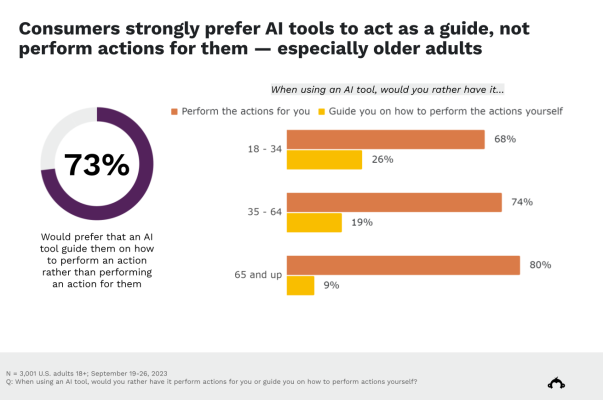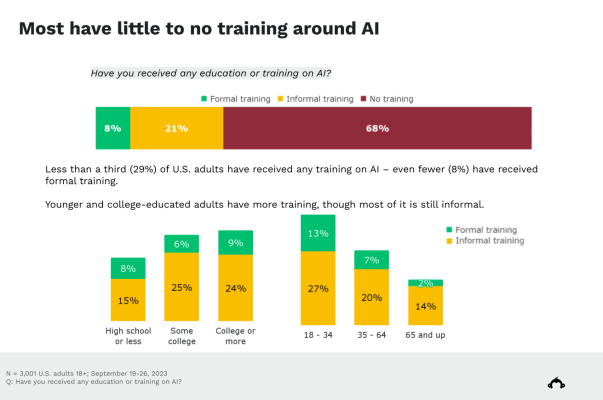Key findings:
- Technical terms can scare users away from AI; a quarter say they would be less likely to use an online tool or website that mentions “generative AI” (26%) or “chatbot” (26%)
- Most are unfamiliar with technical terms like “predictive analytics” (39% are familiar), “machine learning” (38%), “generative AI” (33%), “neural network” (25%), or “deep learning” (24%)
- Consumers have a strong preference for having an AI tool guide them on how to perform an action (73%) over performing an action for them (19%)
- Very few have received any formal training on AI (8%), but more than half of workers (54%) are currently using AI for their jobs
Americans are more concerned than excited about the impact of AI on their lives
It looks like the AI hype is here to stay. According to a new SurveyMonkey poll conducted September 19-26 among U.S. adults, more than a third (36%) hear people they know talking about AI daily or weekly; this is unchanged from when we asked in another poll in April of this year (37%). But the percentage who believe AI will have a major impact on their lives in the next 5 years has increased by 7 percentage points since that April poll, from 52% to 59%.

With all this chatter around AI, it’s becoming increasingly important to get your AI messaging right to attract customers rather than scaring them away. People are much more concerned than they are excited about AI; only 26% are more excited than they are concerned, with 71% more concerned than excited (43% are somewhat more concerned, 29% are much more concerned). While younger people are more likely to be excited than older adults, they are still overwhelmingly concerned (61% of those ages 18-34 are more concerned than excited, compared with 73% of those ages 35-64 and 82% of those ages 65 and up).
Technical terms around AI can be off-putting
Any AI tool comes with technical terms, like “algorithms,” “machine learning,” or “neural networks.” Most Americans are unfamiliar with at least some of these terms:
- More than half are familiar with the terms “algorithm” (58%), “chatbot” (54%), and “automation” (54%).
- Around a third are familiar with “predictive analytics” (39%), “machine learning” (38%), and “generative AI” (33%).
- Only a quarter are familiar with “neural network” (25%) and “deep learning” (24%).
While more highly educated adults are more familiar with these technical terms, only a third of those with a Bachelor’s degree or higher are familiar with “neural network” (33%) and “deep learning” (31%).

Using these terms can scare customers away; a quarter say they would be less likely to use an online tool or website that mentions “generative AI” (26%) or “chatbot” (26%). One in five would avoid tools that use the terms “deep learning” (20%) or “machine learning” (19%). Fewer are turned off by “predictive analytics” (17%), “neural network” (17%), “algorithm” (16%), or “automation” (15%).
AI tools should act as conversational guides

When it comes to interacting with AI tools, consumers have a strong preference for the AI tool to guide them on how to perform an action (73%) over performing an action for them (19%). This preference is stronger among older adults; 80% of those ages 65 and up and 74% of those ages 35-64 prefer AI to act as a guide, compared with 68% of those ages 18-34. There is also a slight preference for interacting conversationally with an AI tool (48%) versus having the AI present information proactively (42%). Those with a Bachelor’s degree or higher have a stronger preference for conversational interaction (51% prefer conversational and 39% prefer proactive) compared with those with a high school degree or less (44% prefer conversational and 45% prefer proactive).
AI knowledge and training are still lacking among American adults
When people define AI, they are primarily thinking of chatbots (58% are thinking about customer service chatbots; 50% are thinking about standalone chatbots like ChatGPT), AI image and audio generators (55%), smart home systems (47%), and AI filters on social media (43%). Some include things that don’t use AI in their definition, like remote control drones (27%), portable GPS units (22%), bluetooth headsets (16%) and automatic washing machines (14%).

Very few have received any formal training on AI (8%), though slightly more have received informal training like watching videos or reading books or articles (21%). Most have received no training (68%). Those with some college education or a Bachelor’s degree or higher are more likely to have received formal or informal training (31% and 33%, respectively) compared with those with a high school diploma or less (23%). And younger adults ages 18-34 are more likely to have received some form of training (40%), compared with those ages 35-64 (27%) and those ages 65 and up (16%). Despite the lack of training, half (50%) say they are confident that they understand how AI works, and that number is higher among younger adults ages 18-34 (58%, compared with 50% of those ages 35-64 and 39% of those ages 65 and up).
Trust in AI accuracy varies across use cases, but more than half use it for work
Whether consumers trust the accuracy of AI-generated content varies across use cases. For more serious use cases, trust is lower; 41% trust the accuracy of AI “a great deal” or “a fair amount” for diagnosing an illness, 42% trust AI for preparing a legal argument, and 46% trust it for learning about current events, while 53% trust it for drafting a school or work assignment and 55% trust it for planning a trip.
Opportunities to expand AI tools for workers abound, if you get your messaging right. Despite mixed feelings about AI, more than half of adults who are employed full- or part-time are currently using AI for work (54%). A third (32%) are using AI-enabled grammar checkers like Grammarly or Wordtune; fewer are using other types of tools including standalone chatbots like ChatGPT (17%), email inbox management tools like Sanebox or EmailTree (13%), slide deck and presentation tools like Decktopus or Canva (11%), scheduling tools like Reclaim or Clockwise (11%), research tools like genei or Aomni (9%), note-taking tools like Mem or Fireflies (8%), content creation tools like Jasper or Midjourney (8%), and automation tools like Zapier (5%).
Read more about our polling methodology here.
Click through all the results in the interactive toplines below:



